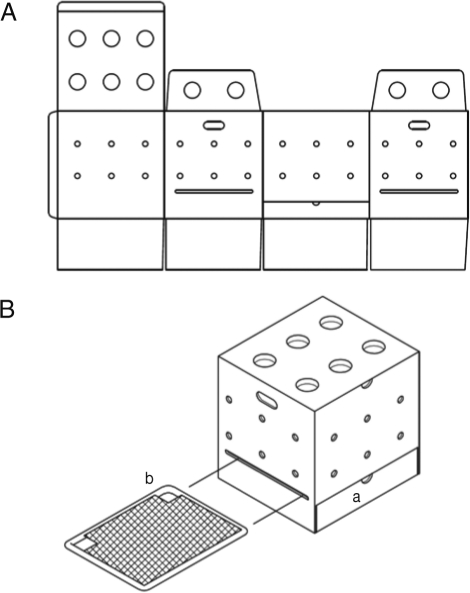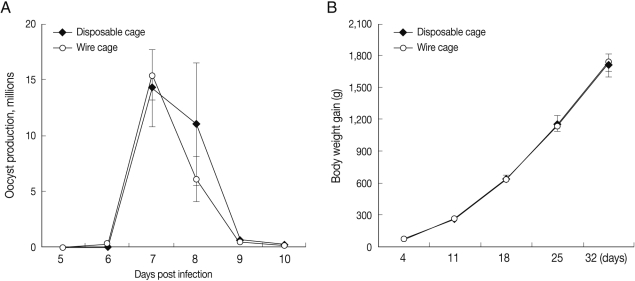Coccidiosis of chickens, one of the most costly diseases affecting the poultry industry worldwide, is caused by infection with one or more of 7 species of the intracellular protozoan parasite Eimeria [1,2]. Eimeria infections occur when susceptible chickens ingest viable sporulated oocysts from contaminated litter. The ingested oocysts invade the intestinal epithelium in a region-specific manner, causing variant pathogenicity in poultry and ranging from reduced feed conversion, hemorrhagic diarrhea, and weight loss to, at times, mortality.
After at least 2 generations of asexual reproduction, several hundred thousand Eimeria oocysts can be produced from a single oocyst, and are excreted in feces over several days or weeks [2-4]. The oocysts have cyst walls that are highly refractory to environmental extremes and disinfectants. Therefore, the oocysts can be transported mechanically by animals, insects, dust, and contaminated feed, water, and other fomites [4-6]. Considering that Eimeria oocysts are highly infectious, easily transferable, and abundant in the environment [7], it is difficult to achieve complete elimination of oocysts in experimental facilities. Thus, a prerequisite for investigating Eimeria spp. is to house infected animals in strict isolation systems to prevent infective oocyst contamination.
A disposable cage, consisting of a disposable cardboard box and reusable plywood, was designed for pathogen studies in small, wild birds [8]. Subsequently, a variety of isolators or cages have been designed for studies of various avian diseases, including coccidiosis [9-13]. However, for experimental studies of Eimeria infection in chickens, these commercially manufactured cages are expensive and difficult to clean and sterilize properly. To overcome these disadvantages, we designed an economical, simple, and disposable cage, and evaluated its ability to eliminate oocyst contamination during experimental Eimeria infections in chickens over the course of 2 years.
Male Cobb 500 chickens were reared under Eimeria-free conditions with unlimited access to feed and water. Constant light was provided for the duration of the experiments. All animal experiments were performed in accordance with the Guide for Care and Use of Laboratory Animals established by Gyeongsang National University.
Cages consisted of disposable cardboard boxes (Wonchang box, Jinju, Korea), reusable plastic cups, and wire netting (Fig. 1). Cages were 400 mm (W)×370 mm (D)×400 mm (H), which housed 3 chicks for 1 month. Feces fall into the bottom regions of the cages through the wire netting. For collection of excreta, the bottoms of the cages were lined with greaseproof paper that could be removed through region (a) of the cage (Fig. 1A and 1B). Air and light were supplied freely through the side and upper holes. Cage roofs were designed to be opened for changing of water and feed, which were provided in 250 ml plastic cups located in region (b) of the cages (Fig. 1B).
To infect Eimeria and assess fecal oocyst production, 4-day-old chickens were orally infected with 1×104 sporulated Eimeria maxima oocysts, and transferred to either wire cages (Farmer Automatic GmbH & Co. KG., Laer, Germany) or disposble cages (3 birds/cage). Fecal materials were collected on days 6-10 post-infection (PI). Eimeria oocysts were isolated from fecal samples by flotation on 6-14% sodium hypochlorite and washed 3 times with PBS. Oocyst counts were assessed using a McMaster counting chamber. Each group consisted of 12 chickens. Total oocyst number per bird was calculated by accounting for fecal sample volumes and the number of birds per cage using the following formula:
Total number of oocysts=oocyst count×dilution factor×(fecal sample volume/counting chamber volume)/number of birds per cage.
Body weights of infected chickens were individually measured on days 1-10 PI. To measure the body weight gain of uninfected chickens, 4-day-old chickens were randomly assigned to either wire cages or disposable cages (3 birds/cage). Body weights were individually measured for 32 days, beginning on day 4. Each group consisted of 12 chickens.
The disposable cages used were made of cardboard boxes that can be incinerated to eliminate residual oocysts after experimental studies with Eimeria spp. (Fig. 1). Because various Eimeria spp. oocysts are highly resistant to environmental conditions and disinfectants [5,7], extreme temperatures and highly toxic chemicals are necessary to eliminate fecal or contaminated oocysts from cages or isolators following experimental Eimeria infection studies. Additionally, it is difficult to wash and properly sterilize chicken cages because the cages are bigger than those used for small animals, such as mice and rats. Therefore, studies of experimental chicken coccidiosis have been limited due to the difficulty of preventing facility contamination by Eimeria oocysts.
To compare disposable cage conditions with those of the traditional wire cages, we evaluated fecal oocyst shedding and body weight gain, the most reliable disease parameters for measuring the effects of coccidiosis [14-16]. No significant differences were noted in fecal oocyst output (Fig. 2A) or body weight gain (data not shown) between infected chickens hous-ed in either disposable or wire cages. Similarly, there were no differences in body weight gain between uninfected chickens housed in either disposable or wire cages for 1 month with 3 birds per cage (Fig. 2B). These data imply that the disposable cages can be used for experimental chicken studies with no effect on experimental outcome compared to wire cages.
Considering that 7 different species of Eimeria can infect chickens and that Eimeria oocysts are easily transferable by insects, dust, and fomites [4,7], contamination can easily occur during Eimeria experiments without the use of sterile isolators or cages. Although the disposable cages were made from cardboard boxes containing holes (Fig. 1), coccidia contamination was detected only in 1 cage (1.7%) of adjacent cages in 5 experiments over the course of 2 years. In contrast, coccidia contamination was found in 24.1% of wire cages (Table 1). The detection limit of fecal examination via microscopy was 50 oocysts per gram of feces. Interestingly, Patton and Sapanski [12] noted that 22% of trials resulted in unscheduled coccidial infection without the use of isolators.
Little progress has been made in either isolator or cage design for Eimeria studies in chickens to prevent contamination of experimental facilities and cross-contamination between cages [12,13]. Therefore, the present study designed a simple, economical, and disposable cage for use in studies of avian coccidiosis that can prevent or greatly decrease oocyst contamination of tools and study environments.








